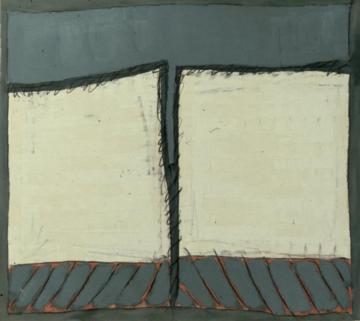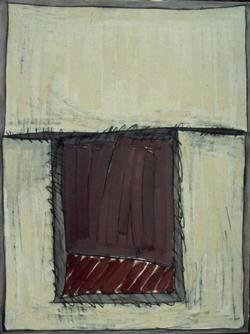| works on paper | prints | sculpture | about the artist | HOME |
| T O N Y C A L Z E T T A | Essay
by John Metcalf |
||||||||
Paintings
about Painting: Tony Calzetta was
born in 1945 in Windsor, Ontario. He attended Catholic schools in Windsor
and went to the University of Detroit, from which he graduated in 1968
with the degree of Bachelor of Science. Most of the courses he took at
university were, however, in math, business studies, and accounting and
his degree might more properly be described as being in Commerce. The paintings that Calzetta
did while at York University are important in terms of the paintings he
would do later; it is possible to see in them the beginnings of his future
vocabulary. But it is with the paintings in his first professional exhibition,
which was in 1977 at the Pollock Gallery, that Calzetta broke through
into what has now become the essence of his work - the combining of drawing
with painting, the use of charcoal to produce a line of marvelous sensitivity. "Charcoal's sensual
pleasure. There's a film on Alechinsky working and there's one part where
he has a huge sheet of paper and he's putting down a line in charcoal
and - oh, God! - the excitement just of the sound."
"Up to the evening of
doing Brantford Arrival I'd been totally unable to use the line
in painting and that evening Andrea's mother and sister were coming over
and I didn't want to be confronted with the situation so I told Andrea
that I was just going to go in the back and paint and they sat in the
living room talking while I was in the back being irritated and this energy
started to flow and I found myself putting down the line and then the
paint. The painting was completed in an hour and a half and during the
doing of it I really wasn't aware of exactly what was happening except
there was all this frustration being released and then I just stepped
back and... there it was. It was a revelation." "God! It's starting
to happen! The following extract from
a review by Kay Woods, a former curator of The Robert McLaughlin Gallery,
appeared in artscanada in 1978 and captures very well certain aspects
of Calzetta's first professional paintings.
The paintings have an assured, finished quality, as though there are few doubts in the artist's mind as he paints. The initial spontaneity in the free line around the edge and in the outline of the forms is somewhat counteracted by the extensive overdrawing. The large canvases retain some of the quality of a wash drawing. In works such as Albert Road Friends [1977] and Meeting Santarosa [1977], although most of the paint appears to have been put on with the roller, there are quick diagonal slashes of paint applied by brush and left exactly as the movement of the brush described them. Nowhere in any of his paintings does one find a "worked-over" area.
The artists that Tony Calzetta has particularly admired are Robert Motherwell, Jasper Johns and Jack Bush. Motherwell's attitude towards painting is also intuitive. The automatism of Surrealism has intrigued both painters, as has the acceptance of the accidental in the creation of a work of art. Frequently seen in Calzetta's work are areas of broad stripes, or rows of slats, at first horizontally placed but now just as often on the diagonal, which could have surfaced through a memory of Motherwell's The Little Spanish Prison or his Wall Paintings with Stripes, both of 1944. But where the bars in Motherwell's work are equated with his reaction to the political oppression in Spain at that time, Calzetta's strips of paint are abstract and without apparent meaning. When diagonally placed they are reminiscent of the wind-driven rain in Calzetta's early drawings. Two features of Johns' work also present in Calzetta's are the extensive use of drawing and frequent division of the surface, as in Johns' Study for Painting with a Ball [1958]. Johns' horizontal or vertical divisions are usually defined by hard-edged slits which divide the entire painterly surface; Calzetta's openings separate his depicted forms in a more soft-edged, sensuous way. It was mainly colour that attracted Calzetta to Bush. In an earlier period of his work colour played a more important role than it does now, with pinks and reds being the most prominent. But what has emerged in his present painting are not the positive hues of Bush's configurations but the subdued, greyed colours of his backgrounds. These more subtle tones, along with gradations from white to black, enhance the gentle, yielding forms. The shapes in Calzetta's paintings are most often likened to doors or windows. A sense of mystery surrounds them since they appear shuttered or closed in some way to block out view, or to conceal whatever is within. The divided rectangles conjure up visions of doors left slightly ajar; in formal terms they effect an illusion of a slight spatial depth which often appears to open out between the picture surface and the viewer. As far as the artist is concerned, however, any such image is imposed upon the work only through the viewer's imagination. He claims the simple forms hold no hidden meanings that he is aware of: they are completely abstract, having emerged "in spite of himself" through his most natural, subconscious gestures. Calzetta is very much concerned with the act of painting and is determined that his art should reflect his own sensibilities, his inner self alone. His aim is the painting made exclusively by line, using the immediate spontaneous gesture directed only by chance... I think that at the time Calzetta was talking to Kay Woods he was either over emphasizing one element of his art or deliberately obfuscating because years later he tells a rather different story about the "Smi" paintings. Prior to his painting Brantford Arrival, he had made something of a fetish of spontaneity, refusing any form of organization before addressing the canvas. Brantford Arrival marked a change in method: "Just prior to doing that painting I'd happened to be doing some small doodlings of images, loose gestural things on pieces of paper and I thought they'd make nice vehicles for this drawing." He goes on - with great defensiveness: "As my visual vocabulary developed, I started to organize more and finally got to the point of using a projector to project small drawings onto the canvas, the spontaneity coming from the impulse of the initial image and then more energy coming as the charcoal line went down." This use of a projector soon ended, however, as Calzetta found it adversely affected the life of the line; the element of "copying" defeated the line's flow, denied its pulse, blunted its response to the pull of the canvas weave. Now, Calzetta plans his images on small sheets of paper and then transfers the general shapes and proportions to the canvas with an ordinary pencil. When the proportions are blocked in, he draws the heavy, rich charcoal lines swiftly and with great sureness. The large size of these first canvases - and of most of his succeeding work - is essential to accommodate the gestural aspects of his work. The canvases are large enough to accommodate the natural sweep and reach of the arm in drawing. When he has worked on smaller canvases, the line becomes cramped and forced, the difference immediately obvious. His insistence on spontaneity and his defensiveness about prior organization stem from his struggle to make his painting unique; spontaneity, he believes, ensures that his work will be entirely his. In a press release that accompanied this first show, he said, "The spontaneity of line for me acts like a signature." Yet Kay Woods' review, with its emphasis on spontaneity, does not capture one of the great contradictions in Calzetta's work; his statements about his paintings reveal him as a romantic, but he is at the same time an extremely formal painter. There is an austerely controlled sensuality about these first paintings, a spareness, which is almost Japanese. In Meeting Santarosa, the "romantic" aspects of the painting are exemplified in the rich colour, the sensitivity of the charcoal line, the "accidental" quality of the texture of the field, and in the painting's movement. But the proportions of the picture, the composition, the stillness - these are both formal and almost classical in temper. This contradiction is a constant in Calzetta's work.
|
|||||||||
| works on paper | prints | sculpture | about the artist | HOME |
Copyright © 2020 Tony Calzetta. All rights reserved.


